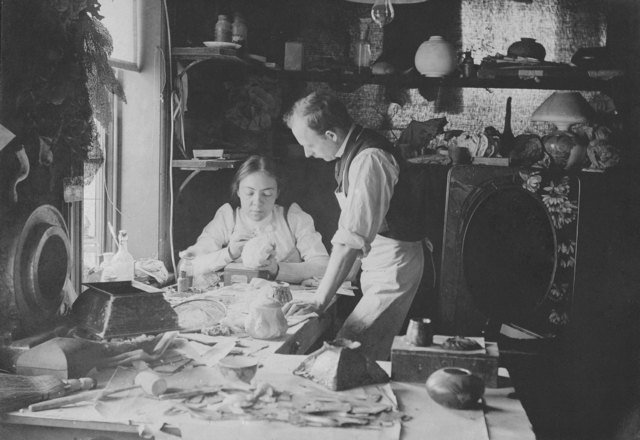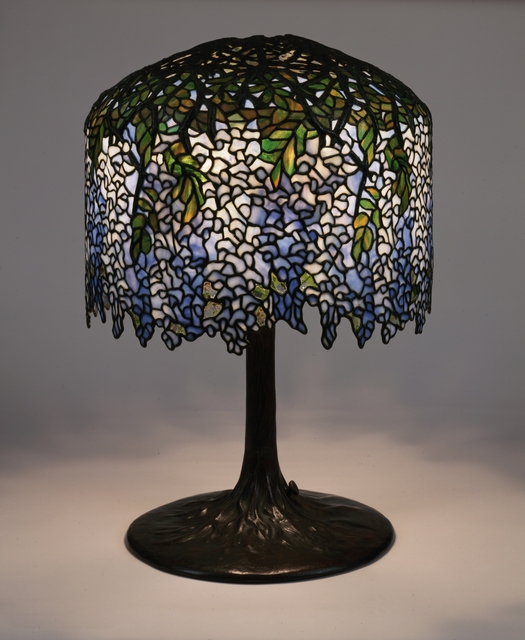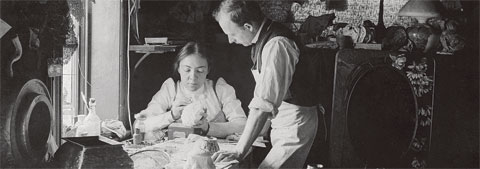Clara Driscoll was a modern woman by turn-of-the-20 th -century standards. She hung out at New York City’s operas and theaters, and she traded her bustle for bicycling. Driscoll excelled in art school, and she even received recognition at the 1900 World’s Fair for one her designs. Driscoll made iconic contributions to the Tiffany legacy and the art nouveau movement—efforts that virtually no one knew were hers until a few years ago. A New Light on Tiffany: Clara Driscoll and the Tiffany Girls focuses not only on Driscoll’s works themselves, but on the historical context of her life and the women’s glass department (also known as the Tiffany Girls) that constructed the lamps. The exhibition came about after the research of two Tiffany scholars collided unexpectedly. Working independently of one another, Martin Eidelberg and Nina Gray discovered a trail of Driscoll’s documents. Once pieced together, the letters and sketches uncovered a startling revelation: Driscoll was the mastermind behind many of Tiffany’s industrial objets d’art, such as the lamps.The story begins in 1837, in New York, when Charles Lewis Tiffany founded Tiffany & Co. The company produced stationary and “fancy goods” such as jewelry, flatware and home accessories. The name was, and is, synonymous with elegant ornamentation and high society. Charles’ son, Louis Comfort Tiffany, served as artistic director of the business and eventually inherited ownership from his father. Louis was an acclaimed designer and gained a reputation creating large-scale, stained glass windows with a special Favrile glass, which he patented. The opalescent glow and variety of textures revolutionized stained glass production and allowed for more subtle, naturalistic details in Tiffany’s objects. Handcrafted Tiffany lamps were introduced in the 1880s, alongside the birth of electricity. The intricate glass shades represented the marriage of classical antiquity and the emerging modernity of the late Victorian era. The Tiffany Girls were responsible for selecting and cutting the delicate, organic shapes of glass for the lamps. Louis Tiffany believed that women were best suited for this work because they had nimble fingers, ideal for slicing the curvilinear shapes. He also thought women had more discerning taste and patience, useful for selecting suitable textures and colors of glass.Tiffany scouted Clara Driscoll for the job of overseeing and designing with the women’s glass department. She evolved her own naturalistic designs, inspired by the flattened, isometric perspective of nature motifs in Japanese art. But Driscoll’s work was largely attributed to Louis Tiffany. “Clara was trying very hard to capture the realism of landscape in these lamps,” says Deb Slaney, curator of history at the Albuquerque Museum of Art and History. Driscoll’s Wisteria lamp, for example, actually looks like the flower, “even to the point where you can see bits of sky popping out through the top." A New Light on Tiffany has traveled internationally since 2007, and thanks to Slaney’s efforts, Albuquerque now hosts this world-class exhibition. The show features more than 60 lamps and various fancy goods, including tea screens and inkwells, all of which were probably designed by Driscoll and the Tiffany Girls. Also on display are pages of the documents, written by Driscoll, that prove she was the artist behind the finery.The museum has been bustling with activity in preparation for the exhibition. Museum Director Cathy L. Wright notes that the show celebrates women “coming into the world.” A full schedule of lectures, family outings, tours, demonstrations and events have been planned in conjunction with the show; patrons can find a schedule on the museum’s website.The exhibition illuminates the dedication and talent of the anonymous women who actually ate their breakfast at Tiffany’s. And the lamps? Well, you’ll eat those up too.
A New Light on Tiffany: Clara Driscoll and the Tiffany Girls Runs through Aug. 21Tuesday through Sunday, 9 a.m. to 5 p.m.The Albuquerque Museum of Art and History2000 Mountain Road NW Tickets: $4, $3 for N.M. residents, $2 seniors and teens243-7255, cabq.gov/museum












